|
June 30 – Monday – Moscow
After breakfast, Jenia gives a talk on our stay in Moscow. She is excellent and covers the history of Russia in a most entertaining hour without missing a beat or using a note.

Jenia |
We watch the landscape on the river become more populated and more industrialized as we get nearer to Moscow. I miss the pastoral scenes.
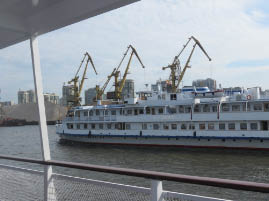
Sailing into Moscow |

Sailing into Moscow |
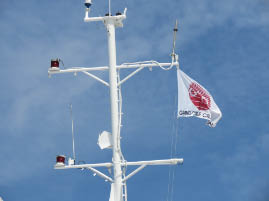
Sailing into Moscow |

Sailing into Moscow |
The ship docks in Moscow about noon. We have a huge lunch with apple crisp and ice cream to follow. We sit with Bill (the Episcopal priest) and wife Lee Ann and a new couple from Atlanta. The guy from Atlanta is a walking germ factory and she is a southern honey.
At 1:30, we board the bus for a city tour of Moscow. Sophia is our guide. She is excellent and dispenses lots of good facts. She points out all the landmarks from the bus window – Stalin high rise and the RR station as we make our way to the first stop. We see where the great artists, writers and important people lived. We pass by many a mansion left over from the days of the Tsars and lovely gardens. The center city neighborhood has a cool vibe – the “in place” to live and of course, very expensive.

Moscow |
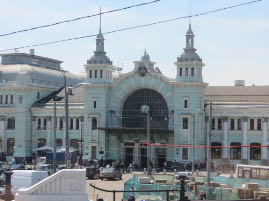
Moscow |

Moscow |
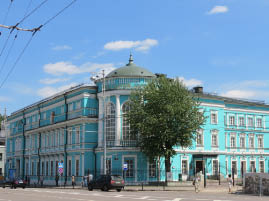
Moscow |
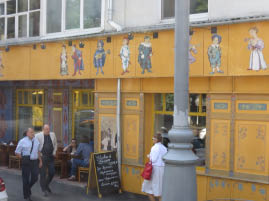
Moscow |
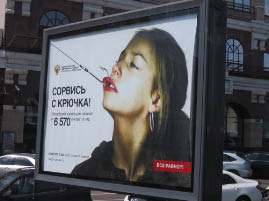
Moscow |
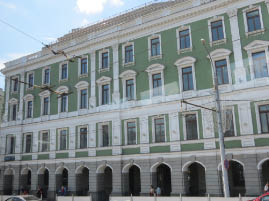
Moscow |

Moscow |
Our first stop is Christ the Savior Cathedral. It was built in 1814 to commemorate the great victory of Alexandra I over Napoleon in the War of 1812. The Cathedral is magnificent and the tallest church in Moscow when it was finished. Fast forward to 1931 when Stalin banned religion from the country -- Stalin was feeling a little insecure when most folks hung on to their old religious roots and were not buying into his communist ideas. Being the vindictive kind of guy that he was, Stalin demolishes this amazing church. The whole thing was blown up in one morning. Luckily the priests saved the model, the plans, and some photos of the paintings and icons. Stalin replaces the empty church property with a heated swimming pool. Now fast forward to 1995 when the mayor of Moscow, Yuri Luzhkov, fills in the heated pool and rebuilds the entire Cathedral. It cost about ¾ of a billion dollars – much of the money donated from everyone in the country. It only takes 5 years to rebuild and what a masterpiece it is! It restores a great deal of Russian pride and helps ease the pain of the terrible Stalin years.

Christ the Savior Cathedral |
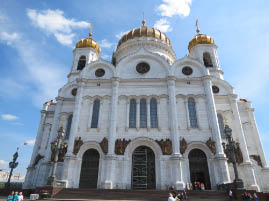
Christ the Savior Cathedral |
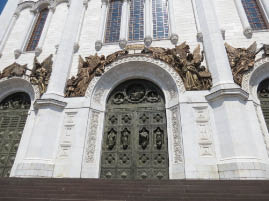
Christ the Savior Cathedral |
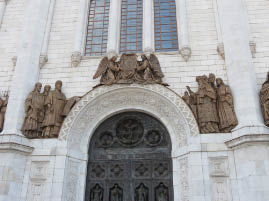
Christ the Savior Cathedral |

Christ the Savior Cathedral |

Christ the Savior Cathedral |

Christ the Savior Cathedral |

Christ the Savior Cathedral |
We have about 15 minutes to go inside and look around. The mean guard at the door doesn’t let me in with my backpack, so Yulie has to wait outside holding on to my stuff. The guards here are most serious about NO PHOTOS – so I’ve no photos of the interior to share.
Christ the Savior Cathedral is an active church, not a museum, so the gals have to cover their heads and knees. The interior blew me away – a huge sanctuary with no pews – but room for 10,000 standing worshippers. I see the coffin of some bygone priest. I watch the people waiting in line to kiss some painting or light a candle. But most of all, I remember the absolutely beautiful frescos that cover the ceilings and walls. However, I never did find the signature of Alexander I (a copy), who defeated Napoleon and then had a vision for this magnificent place.
We walk down a ways through the park and over a foot bridge for some excellent views Moscow and the Kremlin wall. We also see a strange statue referred lovingly to as “Peter Columbus.”
NOTE: A very talented artist thought he’d create a giant statue of Christopher Columbus and sell it to the U.S. to commemorate the 500th anniversary of the discovery of America – and maybe have it placed near the Statue of Liberty. Well, nobody in the U.S. cared about the statue. The artist wasted 18 years and a lot of money before he came up with “Plan B.” He cut off Christopher’s head and replaced it with Peter the Great and then got a Russia to put it in the river right down by Gorky Park. (We get a closer view of Peter Columbus (and better pictures) when we visit Gorky Park on July 2nd.)
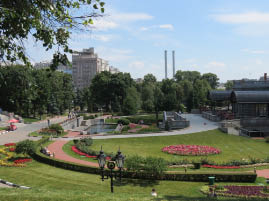
Moscow |

Moscow |
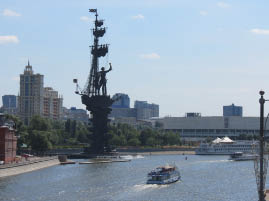
Peter Columbus |
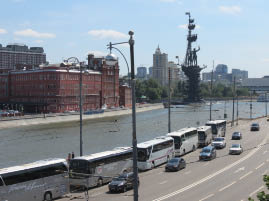
Peter Columbus |

Moscow |
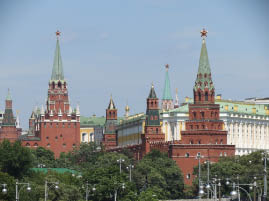
Moscow |
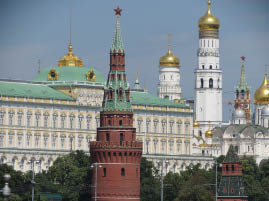
Moscow |
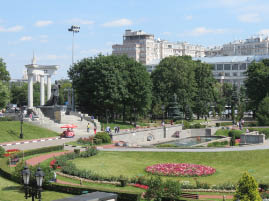
Moscow |
Our next stop is Red Square. What a thrill to be here! The word “red” comes from the Russian word which many centuries ago meant “beautiful.” The square was smaller than I expected. It’s bordered by St. Basil’s cathedral on one side, GUM department store on another and the walls of the Kremlin. Lenin’s tomb (Mausoleum) sits on the square right below the Kremlin’s walls. Stalin’s is buried in a regular grave right next to the Mausoleum. When Stalin died in 1953, he was placed in the Mausoleum next to Lenin, but when people discovered what a demon he was, they removed his body and buried it along the wall with the rest of the leaders. It is said he is encased in concrete as well. Lenin is preserved in formaldehyde, but was not open for visitation today. (NOTE: Bill and I return to visit Lenin on another day. I’m a real sucker for preserved dead leaders – like Mau or Hoi Chi Min. More details later.)
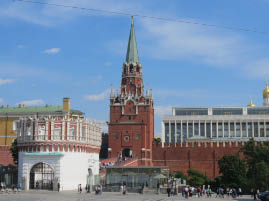
Red Square |

Red Square--State Historical Museum |
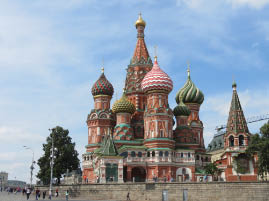
St. Basil's |

St. Basil's |
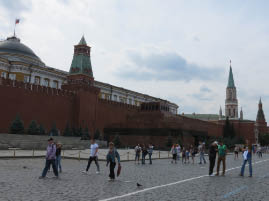
Lenin’s Mausoleum |

Lenin’s Mausoleum |

GUM Department Store |
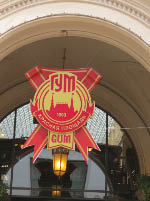
GUM Department Store |
St. Basil’s Cathedral with its colorful onion domes, dominates the square and is just as beautiful as I had imagined. It was built from 1555 to 1560 by Ivan the Terrible to celebrate his victory over the Tatars. It has nine spires and each interior chapel is dedicated to the Saint on whose day Ivan’s men had won major battles. It is said that the two architects’ hands were cut off after they finished the plans so that they could never design another gorgeous cathedral like St. Basil’s. Hey, I’ve had bad bosses before, but working for Ivan the Terrible must have been TERRIBLE!

In front of St. Basil's |

St. Basil's |
Our last stop in Red Square is the GUM Department Store (pronounced “GOOM”). It is a glitzy, 19th century mall – and the fanciest, most elegant, expensive mall I’d ever been in, and I’ve seen quite a few malls in my day. It was originally built in 1892 with 200 market stalls for the wealthy people. It was remodeled in the 1950’s as a showcase to the world that communists delivers the goods just like the other nations – a big fat lie. However, there are still long lines of people waiting to buy, but now they ain’t waiting for a stale loaf of bread like back in the communist days. The goods they’re buying are name brand and pricey and discretionary. All Bill and I could afford was an ice cream cone – also discretionary. We choose pistachio – they are out of chocolate.
NOTE: When the Soviets came to power, they ordered all the religious icons on the buildings destroyed. Turns out, some of the workers in Red Square covered the icons in concrete instead of destroying them. When the buildings were refurbished, the concrete was removed and the icons were there good as new.
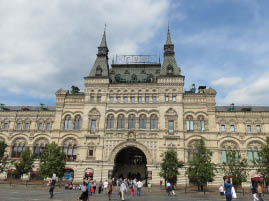
GUM Department Store |
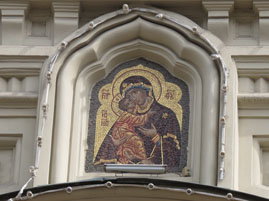
GUM Department Store |
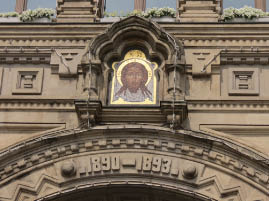
GUM Department Store |

GUM Department Store |
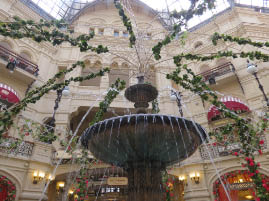
GUM Department Store |

GUM Department Store |

GUM Department Store |
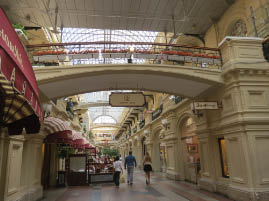
GUM Department Store |

GUM Department Store |
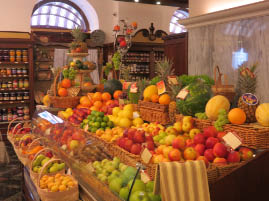
GUM Department Store |

GUM Department Store |

GUM Department Store |

GUM Department Store |

GUM Department Store |
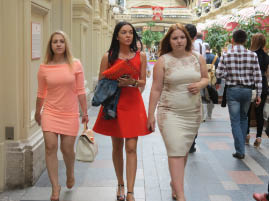
GUM’s real shoppers |
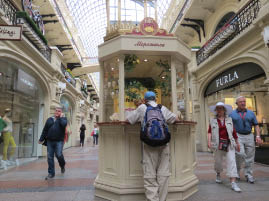
Bill orders pistachio ice cream |
We leave GUM’s and wait for the group. All the new sights energize me. We discover Kazan Cathedral, a small church at the main gate and marvel at the saved icons. Stalin demolished the cathedral in 1936 when he was on his cathedral-demolishing kick. The place was rebuilt in 1994 from old blueprints after the collapse of the Soviet state. The Resurrection Gates were removed in 1931 so tanks could enter for those famous Red Square military parades. They were restored in 1994. So good to see the Red Square, heart of Moscow, returned to its former glory.

Side exit from GUM’s |

Kazan Cathedral |
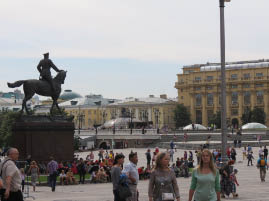
Marshal Zhukov |

Marshal Zhukov pushed back the Germans and captured Berlin in 1945 |

Resurrection Gates |

Resurrection Gates |
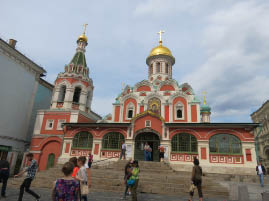
In front of St. Basil's |

Kazan Virgin Icon works miracles |

Zero point of Road Measures at Red Square, Moscow, Russia. |
NOTE: Ivan the Terrible used Red Square for his Festival of Torture. On June 25, 1570, he spent the day entertaining onlookers as 180 prisoners convicted of conspiring against him got poked with hot pokers, sliced with ropes and thrown into a human sized frying pan. Pretty grizzly stuff.
From Red Square Sophia and Yulie take us on a Metro Ride. The Moscow metro is regarded as having the most beautiful stations in the world. The first metro we entered is decorated with life sized bronze statues of military figures and peasants crouching in the arches. Beautiful crystal chandeliers light our way to the underground train. We ride to another station that has mosaics of the history of Russia done in real rubies and diamonds. The metro was built in the 1930’s. There underground stations were designed to give the people their public palaces. There are many more of these “metro gems” buries down underneath the town.
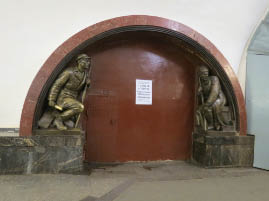
Moscow Metro Station |

Moscow Metro Station |
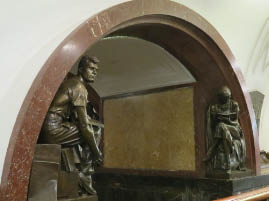
Moscow Metro Station |
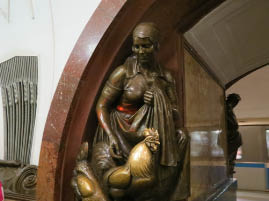
Moscow Metro Station |
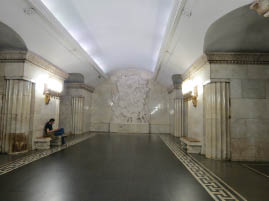
Moscow Metro Station |
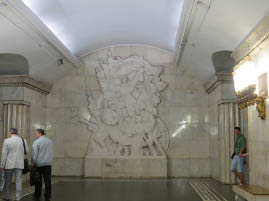
Moscow Metro Station |
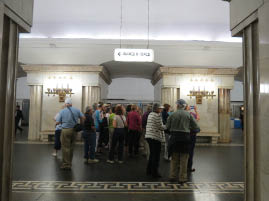
Moscow Metro Station |
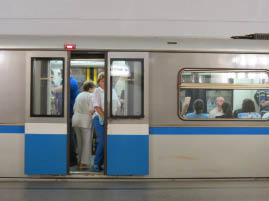
Moscow Metro Station |

Moscow Metro Station |

Moscow Metro Station |

Moscow Metro Station |
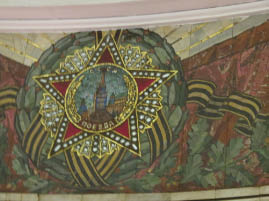
Moscow Metro Station |
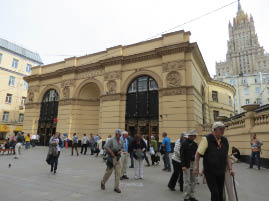
Moscow Metro Station |
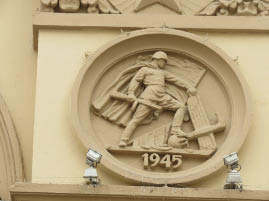
Moscow Metro Station |
We meet the bus at the last metro stop and go back to the ship. I take more street scene pictures from the bus window on the way home and then act goofy with Joan, my favorite pass time.
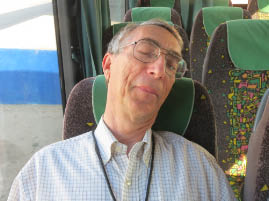
Bob |
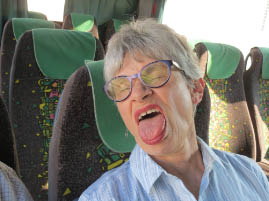
Joan |
Back in our room, I have time for a shower before dinner. We sit with Joan and Bob and have lots more giggles about nothing. Salmon is good. Seems everyone is getting sick – either coming down with a cold or has some stomach issue. We’re doing our best to avoid the walking germ factories. (Hope we don’t get something – knock on wood.)
After dinner we come back to the room to wash and journal – only 3 days left to cover Moscow. It’s a real hoot being here.
July 1 – Tuesday – Moscow
Our day to do the Armory and Kremlin. Our blue group splits into half to maneuver through all the sights. A fun loving little apple dumpling granny with a real love of the place is our guide.
Kremlin is Russian for “fortress” and that’s exactly what it was when Moscow was a medieval walled city on a hill. The Kremlin is basically unchanged since Ivan the Great’s fortifications on the site in the 16th century. Then it was a self-contained city with palaces, armories, fortress and the seat of government.
The total length of the Kremlin’s red brick walls is 7,332 feet and together they form the shape of an irregular triangle. The surrounding walls are sectioned off with 20 large, impressive lookout towers. The highest one is the Trinity tower (Troitskaya Tower), topped with the famous Soviet red star. It is within these walls that Ivan the Terrible carried out his reign of terror. Today Pooty Poot continues with his reign – no extra comment needed.
We pass through the gates and the guards. Once we enter the Kremlin grounds, everything seems much calmer and quieter.

Trinity tower |

Ferocious Guard |
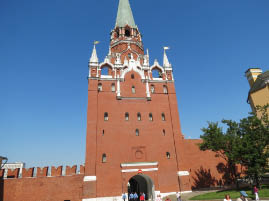
The Kremlin |
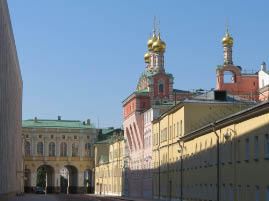
The Kremlin |
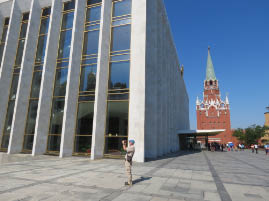
The Kremlin |

The Kremlin |
As we approach Cathedral Square, we see the largest canon in the world which was never fired and we see the largest bell in the world that never rang. The enormous bronze cannon was cast in 1586 and weighs 43 tons. The Tsar Cannon was originally placed on Red Square as a symbol of Russian power.
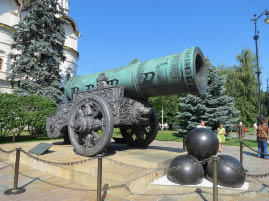
Largest canon in the world |

Largest canon in the world |
The bell, that never rang, was cast (and still in its crate) ready to be hoisted up on Ivan the Great Bell Tower when a fire broke out. The workers did a big No-No. They poured water on the bell causing a huge section to break off. The bell now sits below Ivan the Great Bell Tower, never making its journey up the tower. Ivan the Great Bell Tower was built in the 16th century and once was used as a watch tower. It contains 20 bells and of course, the large big broken one on the ground below.

Ivan the Great Bell Tower |
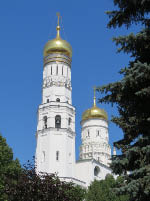
Ivan the Great Bell Tower |
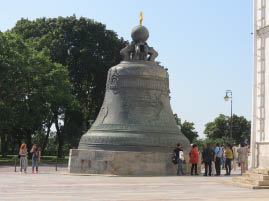
The largest Bell that Never Rang |
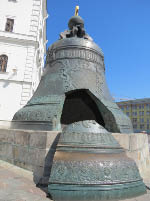
The largest Bell that
Never Rang |
We walk through the beautiful gardens and to the edge of the first wall. Below the wall is another walled-in area called the secret garden. This is where the soldiers once practiced their “goose step” marching. Now part of it is used for a helicopter landing pad. We get great views of the city from the walls of the Kremlin.

Kremlin |
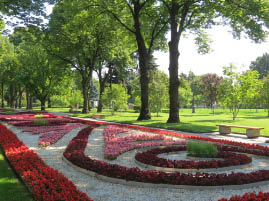
Kremlin |

Kremlin |
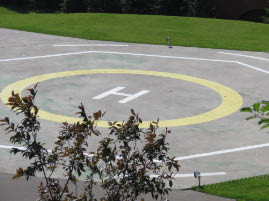
Kremlin |
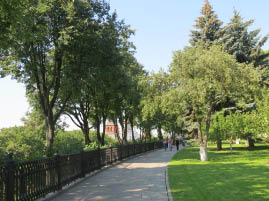
Kremlin |
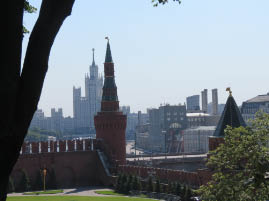
Kremlin |

Kremlin |
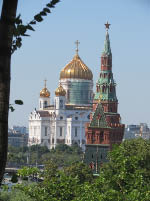
Christ Our Savior Church in the distance |
We enter Cathedral Square. It is the center of the Kremlin and the city’s first great public space in the early 14th Century where all the streets converged. The square gets its name from the three cathedrals facing it – Cathedral of Assumption, Cathedral of the Archangel and Cathedral of the Annunciation. The tallest structure on the square is Ivan the Great Bell Tower.
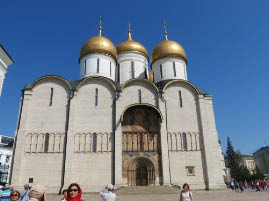
Cathedral of the Assumption |
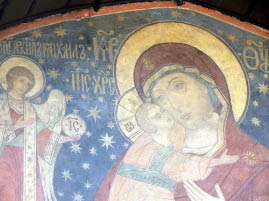
Cathedral of the Assumption |

Cathedral of the Archangels |

Cathedral of the Archangels (with Ivan the Great Bell Tower) |
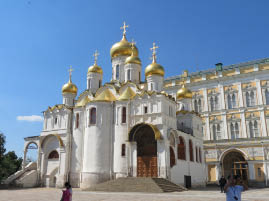
Cathedral of the Annunciation |
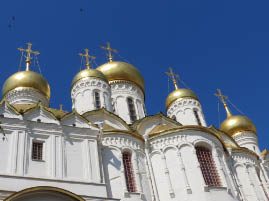
Cathedral of the Annunciation |
All the major events of the royalty (past and present) are held on this square. Even today the square is used for the inauguration ceremony of the President of Russia. The coronations of all the Russian tsars, patriarchs and Grand Dukes of Moscow were held in the Cathedral of the Assumption – and their funeral processions were held right across the way by the Cathedral of the Archangel. The old cathedrals retain the spirits of Ivan the Terrible, Boris Godunov, and the early Romanovs.
In 1710, Peter the Great built a new capital in St. Petersburg and moved everything away from Moscow and the Kremlin. However, the royalty kept returning to Moscow’s Cathedral Square for coronations and burials. The Bolsheviks' chose to move everything back to Moscow as their capital in March 1918 so during Soviet rule the Kremlin again became the great center of power and still is today. However, Lenin and Stalin didn’t leave their Soviet mark on these magnificent cathedrals.
The Faceted Palace, designed by two Italian architects (1485 – 1491), is half way between the two grand churches -- Cathedral of the Assumption and Cathedral of the Annunciation. Faceted Palace gets its name from the Renaissance style faceted stone façade. An external staircase leads to what was once the royal throne room. Today the building is off limits to the public – reserved for visiting dignitaries.
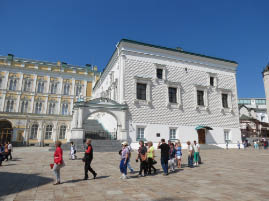
The Faceted Palace |
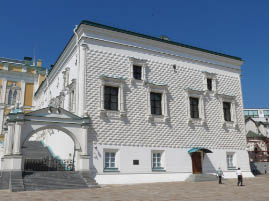
The Faceted Palace |
We spend a lot of time exploring Cathedral of the Assumption. It was built in the 1470’s by Ivan the Terrible as the seat of the Russian Orthodox Church until Peter the Great moved everything to St. Petersburg in 1710.
In fact, the Cathedral of the Assumption is centered on Cathedral Square and happens to be the main cathedral of the Russian State, where the inaugurations of Princes, Tsars, Emperors and heads of the Russian Orthodox Church have been held for centuries. It is also the place of great celebrations. Royals were married here and had their babies baptized here. A young German Princess named Sophia (adopted by Elizabeth I) was married here. Later she had her weak and useless husband rubbed out and became Catherine the Great, one of Russia’s greatest leader.
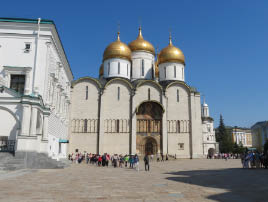
Cathedral of the Assumption |
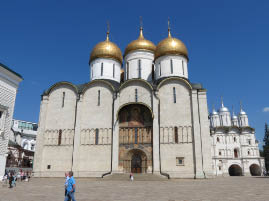
Cathedral of the Assumption |
The interior – sorry no photos allowed -- knocks your socks off with its rounded pillars covered with brightly colored scenes from the Bible and vaulted ceilings topped with 5 massive domes. The main iconostasis (behind the front altar) has five 5 tiers of varying levels of icons with religious significance -- saints, Bible stories, harvest calendar, church name sake, etc. Behind this wall of icons are small chapels representing heaven where only the holy guys can go (to prepared their bread and wine suppers).
The back of Russian Orthodox churches display versions of judgment day – Will it be heaven or hell? Cathedral of the Assumption has a particularly brutal depiction of judgment day painted over the main exit door. It’s a giant red snake carrying souls (yelling and screaming) into hell. A few winged souls ascend to heaven.
The scenes (frescoes or icons) on the first section of all the walls nearest to the ground (floor) show the worldly / earthy life scenes and the scenes get more Godly / Heavenly as they go up. The Russian Orthodox faith is not very people friendly. There are no pews so the congregation must stand (and suffer).
We exit under the evil snake and are back in the Kremlin’s Cathedral Square. We walk around and see Putin’s office building along with other senate and governmental administration buildings.
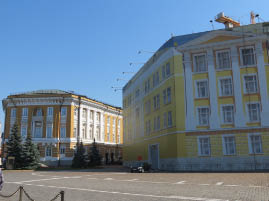
Government Offices |
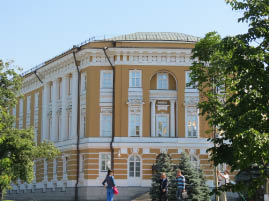
Putin’s Office Building |
The Armory is the oldest museum in Russian and also within the walls of the Kremlin. This 1840’s Russo-Byzantine building was designed to protect the Kremlin’s collection of valuable weaponry, jewels and ceremonial robes and articles. Some of the items here from the 16th Century were originally stored in a stone chamber. Each room of the Armory specialized in something different – Ancient Russian regalia, ceremonial tsar’s dress, priestly vestments, gold and silver, weapons, armor, royal carriages and horse attire (I kid you not).
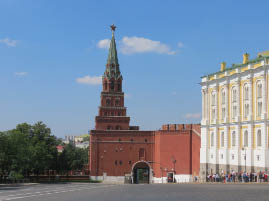
Armory |
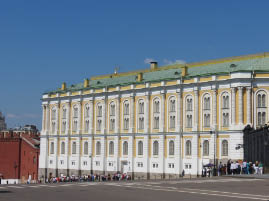
Armory |
No Photos allowed inside – so I’ll share a little visual dump of the place.
The dozen or so carriages were incredible – elaborate, rococo and baroque styles. They were rough to ride in – no springs, no suspension and some with wheels that did not turn.
There were manikins wearing the fashions of the day and displaying the actual coronation / party / wedding dresses. Elizabeth never wore the same gown twice and upon her death, 15,000 gowns were discovered. Most outfits were made of silk that had turned to grey over the centuries and all had very detailed embroidery. It took one person two years to finish the embroidery on one dress.
Shoes and gloves were displayed along with the dresses. Catherine’s shoes looked comfortable. However, in those days, both shoes were exactly the same. The concept that the left shoe and right shoes should be different to fit the foot was not yet invented.
We spent a long time with the Faberge eggs. We were lucky because all the eggs were together in the case (and not on traveling shows). One egg contained an entire train set. Another egg was a gift given by Nicholas II, the last czar of Russian, to his beloved wife Alexandria. It contained tiny pictures of each of their 5 children -- very sweet. They were truly in love. Itís sad to think the whole family would be assassinated together. Our guide really knew the collection. Itís much easier to have someone point of the real treasures.
After a couple of serious hours of intense Armory museum viewing, we emerge back into the bright sunlight and walk out the Kremlin walls and back to the bus. Peaceful, beautiful day at the Kremlin – nothing gray and dreary about this place.

Kremlin |

Kremlin |
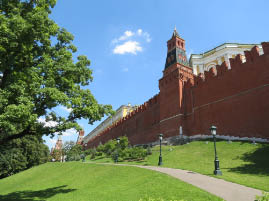
Kremlin |
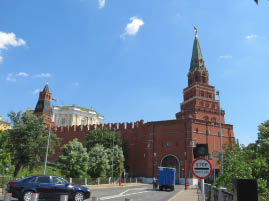
Kremlin |
Next stop LUNCH – and what a nice surprise! The bus takes us to the Hard Rock Café in Moscow. Most of us are longing for a burger and fries, but instead they serve us a 4 or 5 course meal with beef stroganoff over mashed potatoes followed by a brownie and ice cream. I feel the pounds piling on.

Hard Rock Cafe, Moscow |

Hard Rock Cafe, Moscow |

Hard Rock Cafe, Moscow |

Hard Rock Cafe, Moscow |
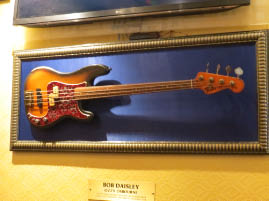
Hard Rock Cafe, Moscow |

Hard Rock Cafe, Moscow |
After lunch we buy Zion a Hard Rock Café t-shirt in the gift shop and then explore the area. We see lots of shops and the house where Aleksandr Pushkin, Russia’s most famous author, lived. Across the street is a statue of Pushkin and his wife – the one he defended in a dual and lost his life.
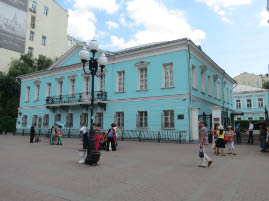
Aleksandr Pushkin's House |

Pushkin and his wife |
We are greeted at the Tikhi Don Ship with big happy “American” smiles from the Captain and Goran, the hotel manager, along with my favorite grinning Russian, the accordion player. Instead of the Tikhi Don, our ship should be named “The Good Ship Lollipop.”

Welcome to Tikhi Don |
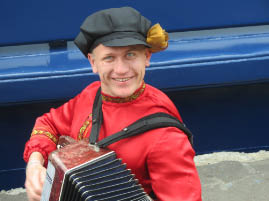
Welcome to Tikhi Don |
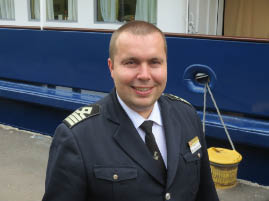
Captain Constantin |

Goron |
At 4:45 we have a light dinner – chicken kebobs and salad -- before our next adventure. (Like we need more food!) We board the bus and head for National Russian Show in the theatre at the Cosmos Hotel. A huge statue of Charles de Gaulle stands 10 stories high to greet you. What’s a guy like that doing here in Moscow?
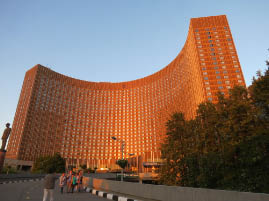
Cosmos Hotel |

Cosmos Hotel |
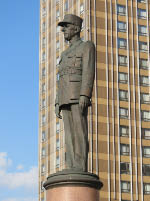
Charles de Gaulle |

Charles de Gaulle |
If you’re wondering what de Gaulle looks at all day … well it’s a massive Soviet Show-off structure anchored on the roads and a Monument to the Conquerors of Space (1964). Nothing subtle in these designs – just big and powerful, intended to make the Soviet heart swell with great national pride.
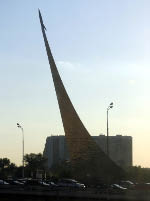
Monument to the Conquerors of Space |
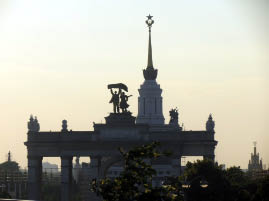
Monument to the Conquerors of Space |
We enter the theater and are delighted with the very good seats. The show absolutely blew us away. It was an amazing dance performance highlighting Russia’s history and national traditions. Everything from the music to the performers, costumes, staging and choreography was first-class and high energy. The guys are incredibly athletic and the gals are so graceful. It looks as if they are floating across the stage. There are no better dancers in the world than Russians! None of us wanted the show to end … but all good things must come to an end. Our happy group jumps back on the bus and heads back to the ship for a late night dinner. We sit with Bob and Joan – but Joan couldn’t eat anything – too late for her sensitive tummy, so I make up for it! He he.

Notice who’s in the background |
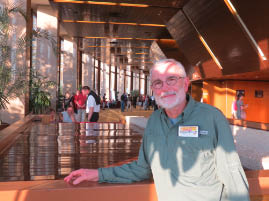
National Russian Show |
July 2 – Wednesdays – Moscow
We catch an optional tour with Jenia to Gorky Park. It is a beautiful day – a perfect day for the park. Gorky Park is Russia’s first theme park and the most famous park in Moscow. It opened in 1928 as the “Park of Culture and Rest,” but it’s now named for the writer Maxim Gorky.
NOTE: The movie “Gorky Park” (1983) was actually shot in Finland – thanks to that darn Cold War.
The park is huge – about 300 acres along the banks of the Moskva river. The park is going through a major renovation with lots of workers, lots of gardeners scattered about. There are many free activities for the citizens of Moscow – free yoga, free lectures, free art lessons, etc. It’s truly a happening place.
Jenia points out the statues and large white letters that say “I love Moscow” just outside the park. Also among the entrance statues is a disturbing display of a little girl in a hour-glass like structure. Looking for meaning -- these Russians can really get to you.

Gorky Park |
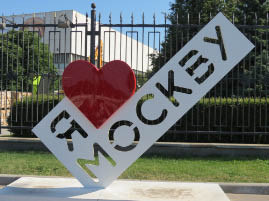
Gorky Park |

Gorky Park |

Gorky Park |
We enter the park, walk past the Tretyakov Museum for 20th Century Art (attached to the Central House of Artists) and wander through a delightful statue garden to kill some time while the others are having a potty break. Most of these statues tickle my fancy. Do they have the same effect on you?

Gorky Park |
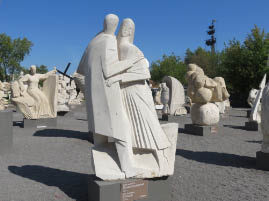
Gorky Park |
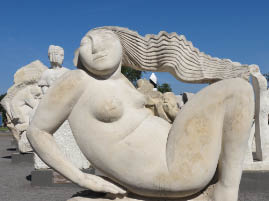
Gorky Park |
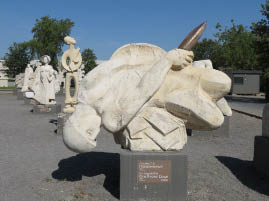
Gorky Park |

Gorky Park |

Gorky Park |
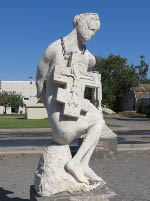
Gorky Park |
Jenia shows us the “Graveyard of Fallen Monuments,” an intriguing collection of old Soviet official statues that are now “fallen idols” and cast away. Somehow they were saved and have a new home in Gory Park. In fact, the only statue of Stalin that is still standing is in this collection. His nose is broken off because the angry crowds weren’t careful when they when they pulled him down. Besides the fallen idols there were several other charming statues scattered about, making it a fun stroll through the park.

Gorky Park |
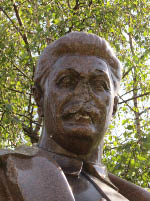
Gorky Park |

Gorky Park |

Gorky Park |

Gorky Park |

Gorky Park |
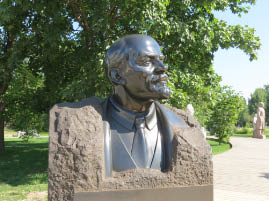
Gorky Park |
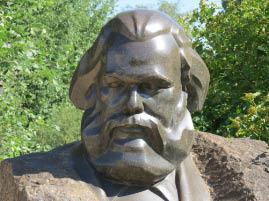
Gorky Park |
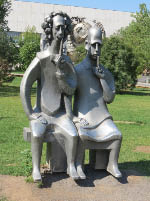
Gorky Park |

Gorky Park |
We continue our walk in the garden and to the banks of the Moskva River where we get better views of “Peter Columbus.” I’ve already shared the story of how Peter Columbus came to park his ship in the river right down by Gorky Park – but here’s a brief review. A clever, resourceful artist spent 18 years and lots of money on his masterpiece of Christopher Columbus hoping to sell it to someone in the U.S. for big bucks. When that didn’t work, he simply cut off Christopher’s head and replaced it with Peter the Great and then sold it to Russia. Russians appreciate art more than we do – that’s for sure.

Peter Columbus |

Peter Columbus |

Peter Columbus |
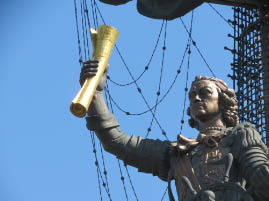
Peter Columbus |

Gorky Park |
After our stroll in the statue park, we visit the Tretyakov Gallery "New Branch," to see the exhibition "Art of the 20th Century." The gallery is in a 1970’s modern building with that 70’s style that feels like it’s from a James Bond movie.

Tretyakov Gallery "New Branch" |

Tretyakov Gallery "New Branch" |
We start at the top floor and wonder through paintings that spans from prerevolutionary work by Chagall, Malevich, and Kandinsky to the socialist realist, modern, and postmodern periods. I didn’t pay the $2 to use my camera so I only have faded memories of what I saw, but I did manage to capture these two shots before the camera guards were on to me.
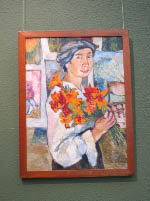
Tretyakov Gallery
"New Branch" |
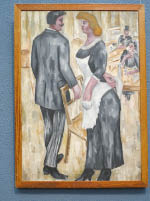
Tretyakov Gallery
"New Branch" |
I especially enjoyed the pieces from the Soviet era onwards. The way the paintings are arranged gives you a good perspective of the progression of the forms of art. It also speaks volumes about the pain the people must have endured. Several of the artists were sent off to Siberia or executed for the ideas they put on canvas. We have never seen such a collection in the U.S. – the oppressed, repressed feelings burst out against the walls. A lot of bleak scenes, not the Normal Rockwall stuff from the good ole U.S. of A.
We take a break and go outside to eat our sandwiches, then return for more visuals than my brain could possibly retain. We see an exhibition of theatre in Moscow during the Tsars’s time with drawings of the sets and costumes. I swear Russian produces the best artists, actors, musicians, dancers – You name it. Very impressive.
We catch the metro back to the ship and are treated to another elegant metro station. This one specialized in ruby and gold mosaics.
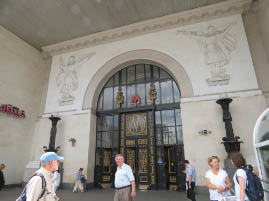
Metro Station |
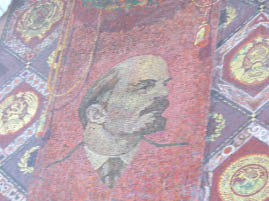
Metro Station |
We take our long walk back to the boat dock. We refresh ourselves with a beer and get ready for the circus tonight and of course, add that light dinner. The pasta and salad were delicious.
We board the bus to ride to the Moscow Circus on Tsvetnoy Boulevard. Traffic is not bad so we arrive early and have a chance to mix with the locals at a park across from the Circus building. Most are parents who are taking their kids to the circus. The place is packed. The kids are adorable. Most of the families here only have one kid. We watch the kids play and climb on the circus-inspired statues.

Moscow park |
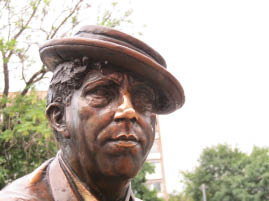
Moscow park |
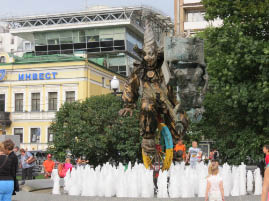
Moscow park |
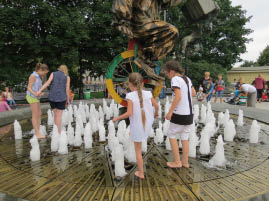
Moscow park |
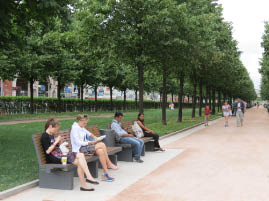
Moscow park |

Moscow park |

Moscow park |

Moscow park |
The Nikulin Circus, named after Yuri Nikuli, a famous clown, is one of the oldest circuses in Russia. More than 100 years ago, in 1880, the building on Tsvetnoy Boulevard was built for another circus. That building was readjusted and rebuilt over the years. After the revolution, the Circus on Tsvetnoy became the first state circus. In 1983, the People's Artist of the USSR selected the famous clown and actor Yuri Nikulin to become the new circus director. By the way, he was already 50 when he became a clown. He’s dead now – we’ll visit him tomorrow in his cemetery plot. His son, Maxim Nikulin, became the next director.
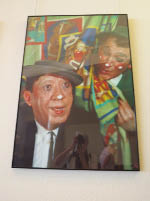
Moscow Circus |
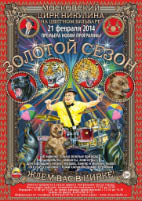
Moscow Circus |
We enter the new circus building. The lobby holds all sorts of capitalist activities – selling cotton candy, toys and even the opportunity to have your picture taken with a wild animal (which I find most distasteful for the animals). With all the little Russian munchkins running around in the lobby, the place was a zoo – of should I say “circus?”
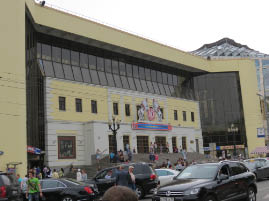
Moscow Circus |
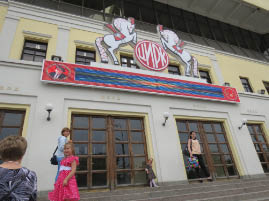
Moscow Circus |
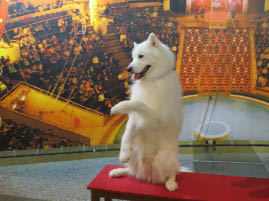
Moscow Circus |
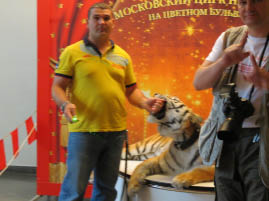
Moscow Circus |
I was glad when the bell rang and we found our way to our wooden circus seats. Even though there were 2,000 in the audience, the one-ring circus has an old-fashioned, intimate, cozy feel about it.
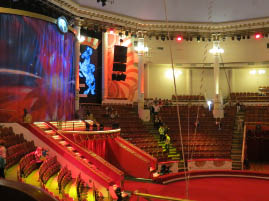
Moscow Circus |

Moscow Circus |
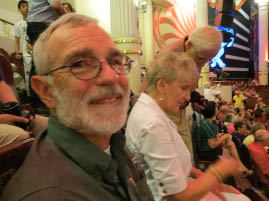
Moscow Circus |
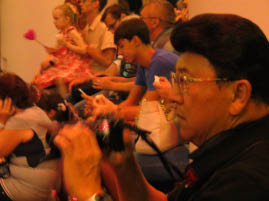
Moscow Circus |
The band and the dancers were energetic and cheerful. I tolerated the group of clowns while the kids laughed heartily at them. However, half way through the show, one clown, who was the MC (and somewhat aging) won my heart when he directed the entire audience with just one simple whistle. He ended with an astonishing drum solo
The jaw-dropping acrobats and trapeze artists did the impossible and survived! The one act that I found strange was with a group of the wild cats – leopard, tigers, cheetahs -- lead by a middle aged couple who made sexual advances toward each other and toward the animals. She was scantily dressed in a leopard outfit and was more than likely, a cheetah. Please, there are children here … In spite of that, it was a beautiful, fun show – the way circuses should be!

Moscow Circus |
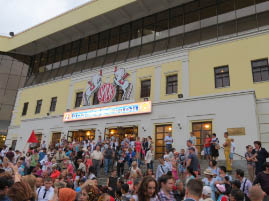
Moscow Circus |
We all leave the performance joyful and full of energy. Energy enough to wolf down our second dinner back on the ship. We ate chef salad, followed by ice cream sundaes with Bill and Lee Ann. (Joan couldn’t even face the food so she went straight to her room and avoided the dining room altogether.)
July 3 – Thursday – Moscow
We load on the bus for a final scenic tour of Moscow. Traffic is stop and go – much worse than L.A. We see the old familiar sights – getting to know Moscow quite well.
An odd shape collection of modern buildings, called “New Moscow,” catches my eye. These fancy office buildings house the future of Russia – new technology, banking and so on.

New Moscow |
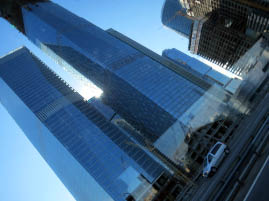
New Moscow |
We stop at Sparrow Hills for a panoramic view of the city. The Russian word for “Love” is displayed proudly on the lookout platform. Everyone wants their picture “From Russia with Love.” Sparrow Hills was once the community for the rich folk. (Moscow has 7 hills – but they are mini-hills.)

From Russia with Love |
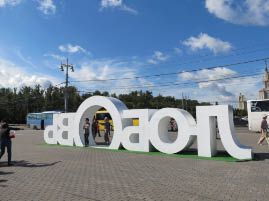
From Russia with Love |
From the platform, we get some great views along with “New Moscow” in the distance and the stadiums left from the 1980’s Olympics. (US didn’t participate in protest of the Russian invasion of Afghanistan – Fate is very strange.) We see the original ski jump and swimming arena. Part of the sky lift is perched right on the edge of the hill.
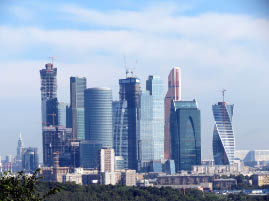
View from Sparrow Hills |
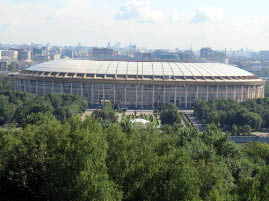
View from Sparrow Hills |
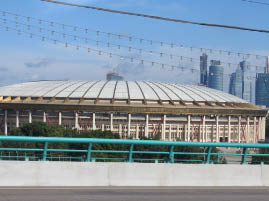
View from Sparrow Hills |
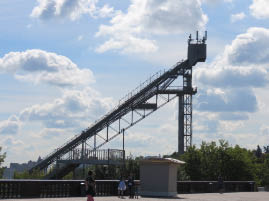
View from Sparrow Hills |
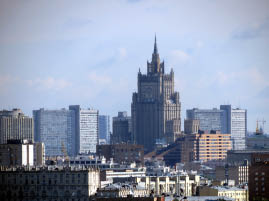
View from Sparrow Hills |
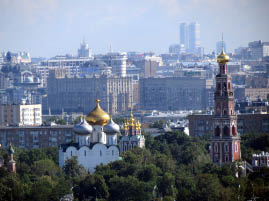
View from Sparrow Hills |
We walk to an active church, Trinity Church on Sparrow Hills, a tiny church that survived 70 years of the USSR. It was unique to me because there are several portraits of “real people” (real men, that is) who are painted on the outside. I assume they are leaders or priests from the church.
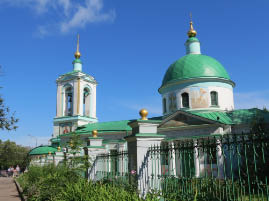
Trinity Church on Sparrow Hills |
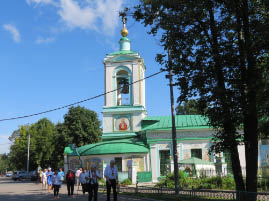
Trinity Church on Sparrow Hills |
 Trinity Church on Sparrow Hills Trinity Church on Sparrow Hills |

Trinity Church on Sparrow Hills |

Trinity Church on Sparrow Hills |
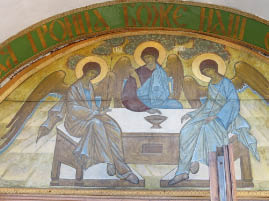
Trinity Church on Sparrow Hills |
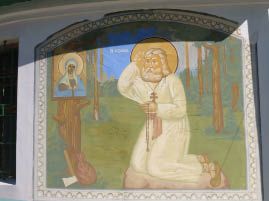
Trinity Church on Sparrow Hills |
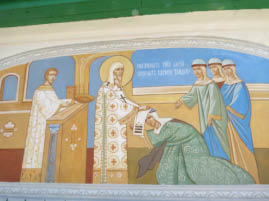
Trinity Church on Sparrow Hills |
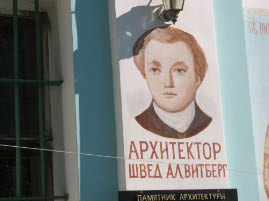
Trinity Church on Sparrow Hills |
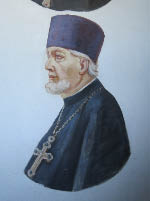
Trinity Church on
Sparrow Hills |
We go inside and find the priests are giving communion. They chant and distribute wine and bread to the handful of aging parishioners, mostly old women probably about my age. The head Father gives a brief message. Yulie later translates the message. They are praying for their boys (and gals) that would be going to Ukraine for battle, I suppose. They even brought out an old 1803 icon of Mary to energize the prayers. Yulie said the service was very special occasion. I saw it all, but didn’t feel right about photographing the people who were there to pray, not to be models for me.
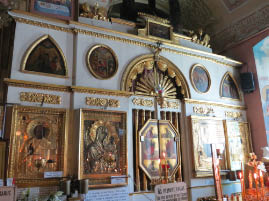
Trinity Church on Sparrow Hills |
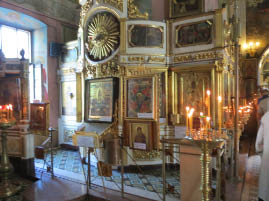
Trinity Church on Sparrow Hills |

Trinity Church on Sparrow Hills |

Trinity Church on Sparrow Hills |
After the church, I dash across the street to take photos of Moscow State University (1949 – 53). It is perfectly symmetrical and the largest of Stalin’s seven towers (which he considered to be sky scrapers). Mikhail Gorbachev studied law here – He was reported to be a gifted student.
We board the bus and head for the New Maiden Necropolis. There were several buildings, among which was a convent started in 1524, but we only visit the quiet cemetery. If these walls could talk – WOW. Sophia, the ambitious sister of Peter the Great, was “imprisoned” here when Peter decided he didn’t need her to mess in his business running the country. Later, on these very grounds, the Lenin and the revolutionists organized their takeover of 1917.
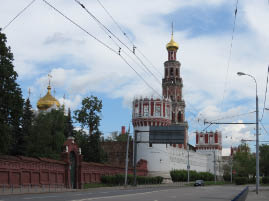
New Maiden Necropolis |
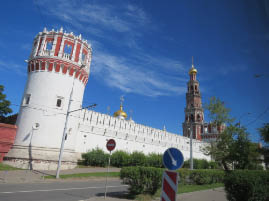
New Maiden Necropolis |
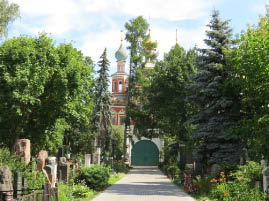
New Maiden Necropolis |
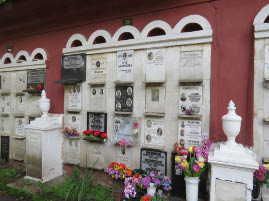
New Maiden Necropolis |
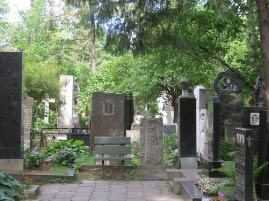
New Maiden Necropolis |
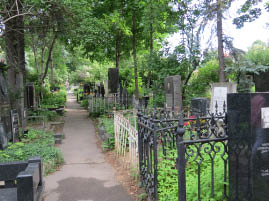
New Maiden Necropolis |
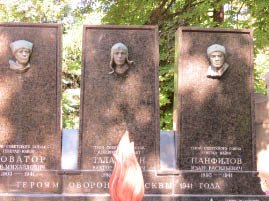
New Maiden Necropolis |
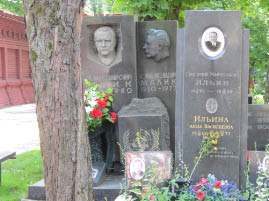
New Maiden Necropolis |
We walk through the peaceful cemetery as Yuila points out where some of Russia’s famous folks now rest in peace. We first stop in the neighborhood plots for the artists – the circus guy (Yuri Nikuli), opera singer, dancers and choreographer. The next neighborhood over is home to Russia’s greatest writers and poets. Of course, there’s a large population of military leaders and politicians.
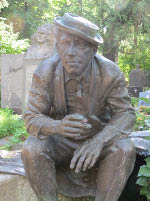
New Maiden Necropolis |
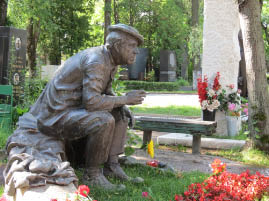
New Maiden Necropolis |
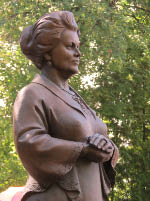
New Maiden Necropolis |

New Maiden Necropolis |
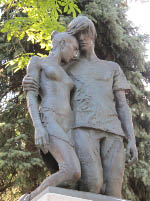
New Maiden Necropolis |
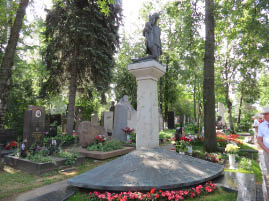
New Maiden Necropolis |

New Maiden Necropolis |
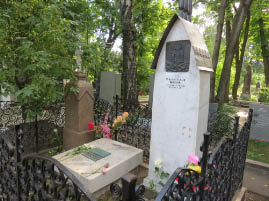
New Maiden Necropolis |

New Maiden Necropolis |

New Maiden Necropolis |
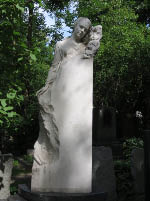
New Maiden Necropolis |
Some of the gravesites touched my heart – here are just a few of them.
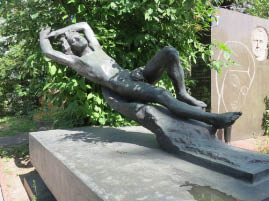
New Maiden Necropolis |

New Maiden Necropolis |
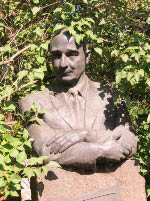
New Maiden Necropolis |

New Maiden Necropolis |
During Soviet times, the cemetery was Russia’s “in place” to be buried. However, only one Soviet leader – Nikita Khrushchev – is buried there. Soviet leaders are traditionally buried alongside the Kremlin Wall in Red Square. The ground rules reserve the wall spots for those who die in office. Khrushchev was removed from power in 1964 and when he died seven years later, he didn’t get a state funeral and a place next to his predecessors. We missed seeing Nikita Khrushchev’s spot because Bill and I must leave the group to grab the metro to get a peek at Lenin in his tomb over in Red Square.
We did see Boris Yeltsin’s grave. Yeltsin, born February 1, 1931; died April 23, 2007, was the first Russian President, serving from 1991 to 1999. His grave marker is very odd and with no name attached.
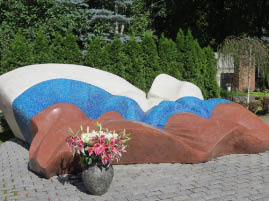
Boris Yeltsin's Grave |
We catch the “red line” metro to Red Square and dash to Lenin’s Mausoleum. We were surprised to see no line waiting to see Lenin. There was only an area cordoned off by a low hanging chain. When I throw my foot over the insignificant barrier, I am besieged by Soviet guards directing us to a line of folks in the distance, so off we go to cue up. The wait outside the metal detector isn’t too bad. 20 minutes or so and we are on our way.
One section of the Kremlin Wall behind Lenin’s mausoleum was first used as a cemetery in 1917 when the bodies of 238 Bolshevik revolutionary fighters were buried in mass graves. Since then over 100 Soviet heroes have their ashes interred in the wall marked with plaques. 12 Soviet statesmen, including every leader except Khrushchev have their own individual tombs. (We missed Khrushchev’s tomb over at the New Maiden Necropolis.)
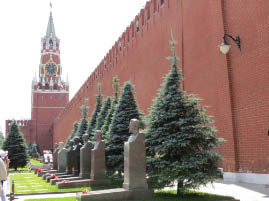
Kremlin Wall |

Kremlin Wall |
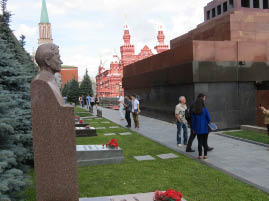
Kremlin Wall |
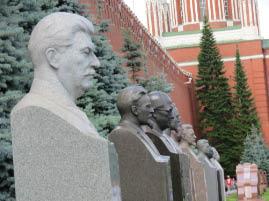
Kremlin Wall |
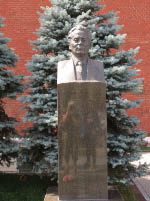
Kremlin Wall |

Kremlin Wall |
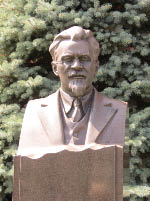
Kremlin Wall |
Buried with the communist leaders in the Kremlin wall is one lone American journalist, John Reed. He was a “former” friend of Lenin’s and author of “Ten Days that Shook the World.” (Warren Beatty played him in the movie “Reds” – oh so such a sad story. He believed in Lenin’s socialism in theory, but soon discovered the leaders were incapable of making it happen in real life. He paid dearly for this mistake.)
When Stalin died in 1953, he was placed in the Mausoleum next to Lenin, but when he fell from favor, he was removed and buried along the wall with the rest – some say encased in concrete.
We enter the black marble mausoleum and go down a series of black marble steps dimly lit. It’s terrible to navigate those steps if one has any problem with night vision. Lenin, born in 1870 and died in 1924, and has been on display here since 1930. He looked awful. His mummy is swabbed weekly with bleach to fight discoloring and mold. Ho Chi Min wins the best mummy by far. Mao could pass, but Lenin looks just plain fake. A wax figure by Madam Trusoe would be far better. I did notice a band aid on Lenin’s right index figure – what’s that all about?
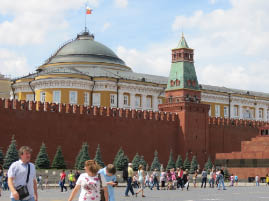
Kremlin Wall |

Lenin's Mausoleum |
After our visit with Lenin, we dash about photographing Red Square. We simply cannot believe we’re here!
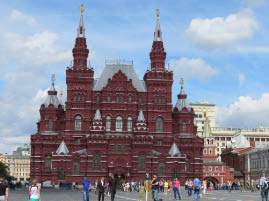
Red Square |
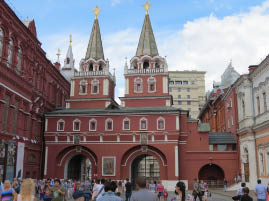
Resurrection Gates |

Marshal Zhukov |
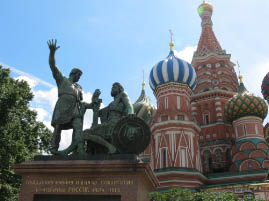
St. Basil Cathedral |
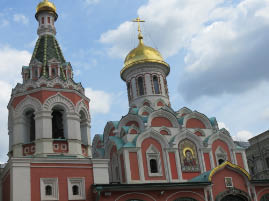
Kazan Cathedral |
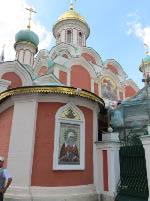
Kazan Cathedral |
We are drawn to St. Basil’s Cathedral – Moscow’s iconic symbol. The outside is so interesting that we just had to get a look at the inside. We buy our tickets and enter. We find an overwhelming maze of chapels stacked on top of each other connected by narrow staircases. Don’t know how any architect could figure that puzzle out. It was like no other cathedral I’d ever seen with frescos of large, colorful flamboyant flowering vines. I enter each chapel, check out the icons, look at the ceiling, and take a few photos before moving on to the next. A group 5 or 6 vocalists sing a cappella in one of the little chapels. The masses follow and find them just in time to buy their overpriced CD’s.
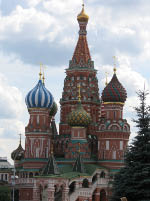
St. Basil's Cathedral |

St. Basil's Cathedral |
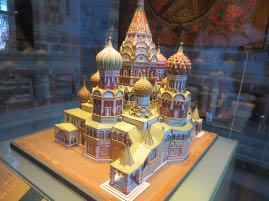
St. Basil's Cathedral |

St. Basil's Cathedral |

St. Basil's Cathedral |
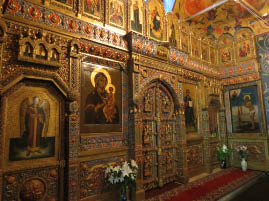
St. Basil's Cathedral |
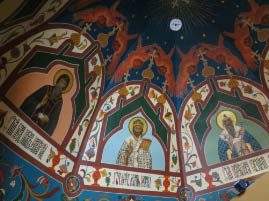
St. Basil's Cathedral |

St. Basil's Cathedral |

Story of Kazan – late 17th copy |

St. Basil's Cathedral |
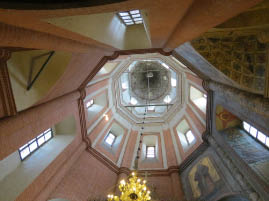
St. Basil's Cathedral |

St. Basil's Cathedral |
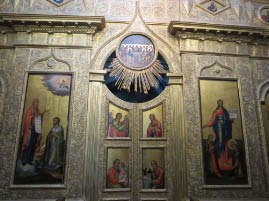
St. Basil's Cathedral |

St. Basil's Cathedral |

St. Basil's Cathedral |

St. Basil's Cathedral |

St. Basil's Cathedral |

St. Basil's Cathedral |

St. Basil's Cathedral |

St. Basil's Cathedral |
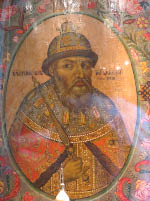
St. Basil's Cathedral |
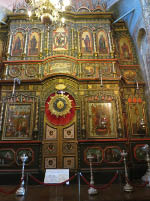
St. Basil's Cathedral |
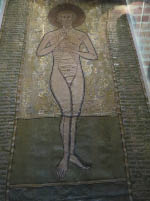
St. Basil's Cathedral |

GUM’s Department Store |
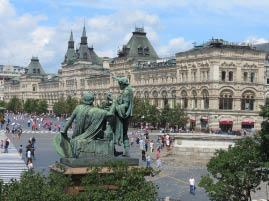
GUM’s Department Store |
We finish our tour of the chapel about 1:30 and look for a bench to eat our sandwiches. GUM’s department store is packed. We finally spot a place outside in the garden and wolf down our lunch. We dash off to catch the metro to the Pushkin Museum of Fine Arts.
We emerge from the metro right by the Christ the Savior Cathedral and walk to the Pushkin Museum of Fine Arts, opened in 1912. The tour books could not say enough about its magnificent collection of art.
The line outside was very, very long, waiting for the new exhibition of Renaissance art. We wait in line for 45 minutes until we get the tickets. We dash from one enormous room after another with their treasures from Egypt, China, Italy, Greece, etc. We’re on a mission to see the collection of impressionist / post- impressionist works that the guide books all boast of. We find one person who speaks English. He tells us that impressionist collection is in a building next door – another ticket, another line. We get over our disappointment quickly and adjust our heads to marvel at the amazing Renaissance collection that has all these Russians ga-ga.
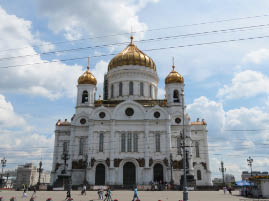
Christ the Savior Cathedral |
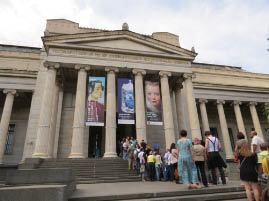
Pushkin Museum of Fine Arts |

Pushkin Museum of Fine Arts |

Pushkin Museum of Fine Arts |
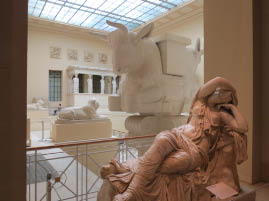
Pushkin Museum of Fine Arts |
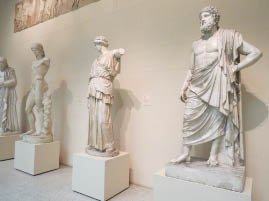
Pushkin Museum of Fine Arts |
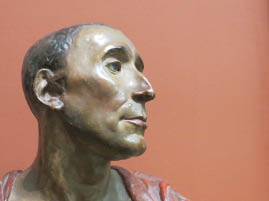
Pushkin Museum of Fine Arts |
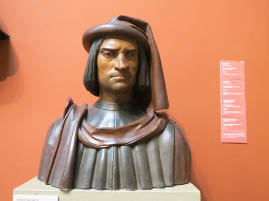
Pushkin Museum of Fine Arts |
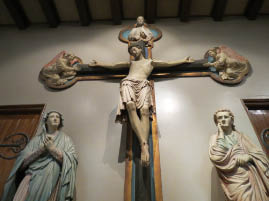
Pushkin Museum of Fine Arts |

Note the Ironing Board Shields |
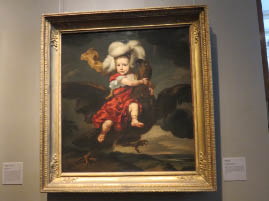
Pushkin Museum of Fine Arts |

Reubens |

Pushkin Museum
of Fine Arts |
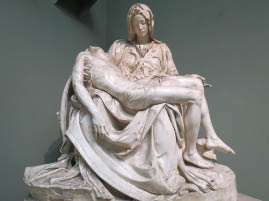
Pushkin Museum of Fine Arts |

Pushkin Museum
of Fine Arts |

Pushkin Museum of Fine Arts |

Napoleon |

Josephine |

Pushkin Museum of
Fine Arts |

Pushkin Museum of
Fine Arts |

Pushkin Museum of
Fine Arts |
Please note that the following two pictures are from the Renaissance Art show. A kindly guard informed me that photos weren’t allowed for this show. OOPS – this is an example of what people were dying to see. Three or four rooms were filled with this caliber of Renaissance Art from the 14th century. The colors were incredible on all of them – I marvel at the restoration. It is clear to me that Russian people appreciate great art, great music, great dance far more than us culturally-deprived folks from across the sea.
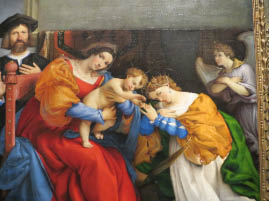
Renaissance Art show |

Renaissance Art show |
NOTES: The first painting was done by Lorenzo Lotto (1480 – 1557). He was a Northern Italian painter of the high-Renaissance in the Venetian school. He was also a draughtsman and illustrator and painted mainly altarpieces, religious subjects and portraits. He is criticized for painting stiff necks; apparently not cool for a Renaissance guy. I think he just like women to look that way.
The second painting of the guy in the pink shirt, "Portrait of Giovanni Benedetto Caravaggi" (1517-20), was painted by Giovanni Cariani (1490 – 1547), an Italian painter also of the high-Renaissance. He hung out a lot in Venice and was very popular.
We are exhausted from our fast pace and finally catch a metro – then change to the line to takes us back to our ship. We get back about 5:30 with lots to do on our last night – say good bye to our friends, pay bills, buy one last souvenir, shower, pack, and so on. By 7, we’re ready for dinner. We sit with Bob and Joan and another couple Pat and Gary (in the missionary business). We’ll ready miss these darling servers who are always happy and smiling. It’s been a wonderful trip.

Last look at Moscow from our cabin window |
It’s funny how I never thought of anything Russian prior to coming on this trip. Now, I’m a sponge, absorbing everything I can about its history and culture.
July 4 – Thursday – Moscow – San Diego
We have our last breakfast on the ship. Luckily we have a later departure – leaving at 8 am. The traffic is the worst and it takes an hour to go just 15 or so miles. We check into the new international airport and wait for our flight that leaves at noon for New York. Bob and Joan are on the same flight. The flight is about 9 hours. I’m in the middle seat in a packed airplane. We pass the time watching movies, eating and trying to sleep.
We get to New York about 3, and have a very expensive beer to celebrate the trip. The flight to San Diego is 20 minutes late. It is packed except for one vacant seat – the seat between Bill and me. What luck! I manage to sleep for almost 5 whole hours, in spite of the 4 nosy kids behind us.
We arrive in San Diego and by 8 pm, we collect our luggage and find our family (with Molly, the peeing dog). We go back home – to Home Sweet Home. Our family stays and chats for a couple of hours. It’s so great to be home. Happy 4th of July! I really liked visiting Russia, but I’M PROUD TO BE AN AMERICAN!!! |











